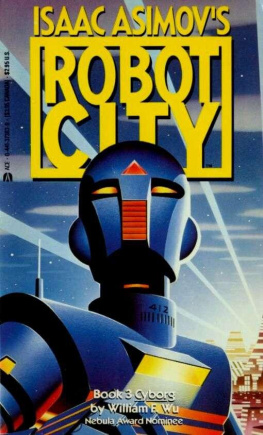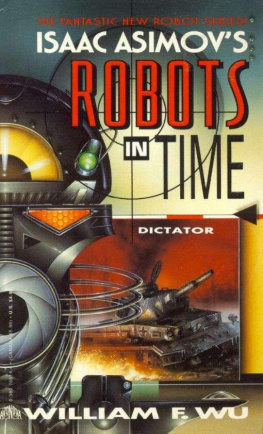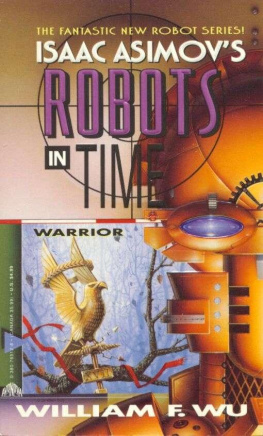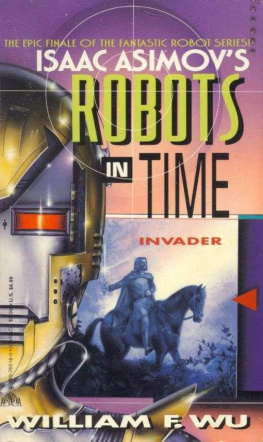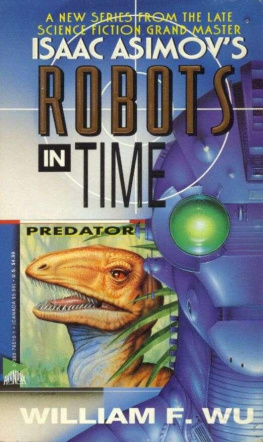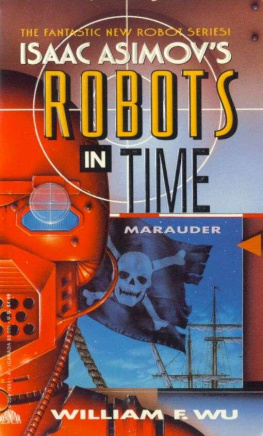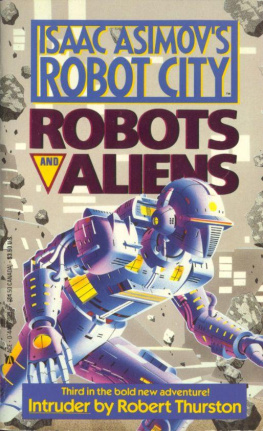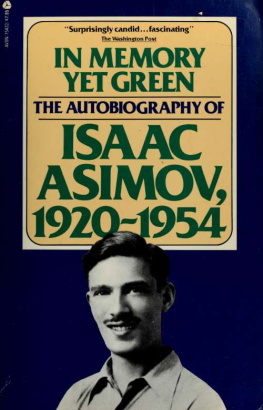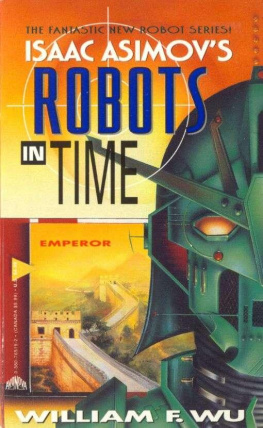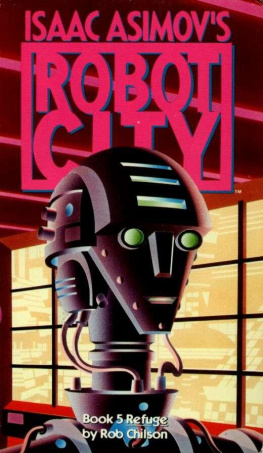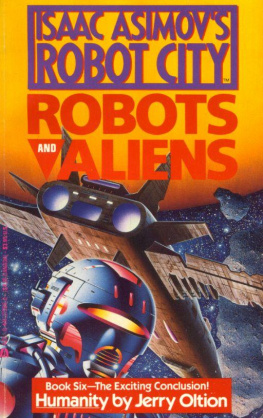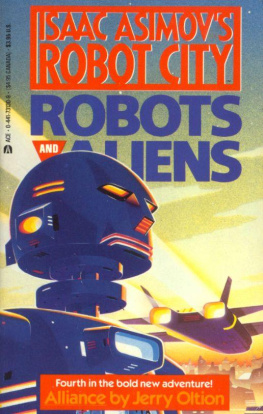William F. Wu - Isaac Asimovs Robot City Book 3: Cyborg
Here you can read online William F. Wu - Isaac Asimovs Robot City Book 3: Cyborg full text of the book (entire story) in english for free. Download pdf and epub, get meaning, cover and reviews about this ebook. year: 1988, publisher: Ace Books, genre: Detective and thriller. Description of the work, (preface) as well as reviews are available. Best literature library LitArk.com created for fans of good reading and offers a wide selection of genres:
Romance novel
Science fiction
Adventure
Detective
Science
History
Home and family
Prose
Art
Politics
Computer
Non-fiction
Religion
Business
Children
Humor
Choose a favorite category and find really read worthwhile books. Enjoy immersion in the world of imagination, feel the emotions of the characters or learn something new for yourself, make an fascinating discovery.
- Book:Isaac Asimovs Robot City Book 3: Cyborg
- Author:
- Publisher:Ace Books
- Genre:
- Year:1988
- Rating:3 / 5
- Favourites:Add to favourites
- Your mark:
- 60
- 1
- 2
- 3
- 4
- 5
Isaac Asimovs Robot City Book 3: Cyborg: summary, description and annotation
We offer to read an annotation, description, summary or preface (depends on what the author of the book "Isaac Asimovs Robot City Book 3: Cyborg" wrote himself). If you haven't found the necessary information about the book — write in the comments, we will try to find it.
Isaac Asimovs Robot City Book 3: Cyborg — read online for free the complete book (whole text) full work
Below is the text of the book, divided by pages. System saving the place of the last page read, allows you to conveniently read the book "Isaac Asimovs Robot City Book 3: Cyborg" online for free, without having to search again every time where you left off. Put a bookmark, and you can go to the page where you finished reading at any time.
Font size:
Interval:
Bookmark:
Isaac Asimov'sRobotCityBook 3: Cyborg
ISAAC ASIMOV'S
ROBOT
CITY
BOOK 3: CYBORG
WILLIAM F. WU
Copyright 1987
ACKNOWLEDGMENTS
Special thanks for help in writing this novel are due to David M. Harris, Michael P. Kube-McDowell, Rob Chilson, Alison Telure, my parents, Dr. William Q. Wu and Cecile F. Wu, and Plus Five Computer Services, Inc.
This novel is dedicated to
Laura J. Lehew
who always remains very special
CYBERNETIC ORGANISM
ISAAC ASIMOV
A robot is a robot and an organism is an organism.
An organism, as we all know, is built up of cells. From the molecular standpoint, its key molecules are nucleic acids and proteins. These float in a watery medium, and the whole has a bony support system. It is useless to go on with the description, since we are all familiar with organisms and since we are examples of them ourselves.
A robot, on the other hand, is (as usually pictured in science fiction) an object, more or less resembling a human being, constructed out of strong, rust-resistant metal. Science fiction writers are generally chary of describing the robotic details too closely since they are not usually essential to the story and the writers are generally at a loss how to do so.
The impression one gets from the stories, however, is that a robot is wired, so that it has wires through which electricity flows rather than tubes through which blood flows. The ultimate source of power is either unnamed, or is assumed to partake of the nature of nuclear power.
What of the robotic brain?
When I wrote my first few robot stories in 1939 and 1940, I imagined a positronic brain of a spongy type of platinum-iridium alloy. It was platinum-iridium because that is a particularly inert metal and is least likely to undergo chemical changes. It was spongy so that it would offer an enormous surface on which electrical patterns could be formed and un-formed. It was positronic because four years before my first robot story, the positron had been discovered as a reverse kind of electron, so that positronic in place of electronic had a delightful science-fiction sound.
Nowadays, of course, my positronic platinum-iridium brain is hopelessly archaic. Even ten years after its invention it became outmoded. By the end of the 1940s, we came to realize that a robot's brain must be a kind of computer. Indeed, if a robot were to be as complex as the robots in my most recent novels, the robot brain-computer must be every bit as complex as the human brain. It must be made of tiny microchips no larger than, and as complex as, brain cells.
But now let us try to imagine something that is neither organism nor robot, but a combination of the two. Perhaps we can think of it as an organismrobot or orbot. That would clearly be a poor name, for it is only robot with the first two letters transposed. To say orgabot, instead, is to be stuck with a rather ugly word.
We might call it a robot-organism, or a robotanism, which, again, is ugly, or roborg. To my ears, roborg doesn't sound bad, but we can't have that. Something else has arisen.
The science of computers was given the name cybernetics by Norbert Weiner a generation ago, so that if we consider something that is part robot and part organism and remember that a robot is cybernetic in nature, we might think of the mixture as a cybernetic organism, or a cyborg. In fact, that is the name that has stuck and is used.
To see what a cyborg might be, let's try starting with a human organism and moving toward a robot; and when we are quite done with that, let's start with a robot and move toward a human being.
To move from a human organism toward a robot, we must begin replacing portions of the human organism with robotic parts. We already do that in some ways. For instance, a good percentage of the original material of my teeth is now metallic, and metal is, of course, the robotic substance par excellence .
The replacements don't have to be metallic, of course. Some parts of my teeth are now ceramic in nature, and can't be told at a glance from the natural dentine. Still, even though dentine is ceramic in appearance and even, to an extent, in chemical structure, it was originally laid down by living material and bears the marks of its origin. The ceramic that has replaced the dentine shows no trace of life, now or ever.
We can go further. My breastbone, which had to be split longitudinally in an operation a few years back, was for a time held together by metallic staples, which have remained in place ever since. My sister-in-law has an artificial hip-joint replacement. There are people who have artificial arms or legs and such non-living limbs are being designed, as time passes on, to be ever more complex and useful. There are people who have lived for days and even months with artificial hearts, and many more people who live for years with pacemakers.
We can imagine, little by little, this part and that part of the human being replaced by inorganic materials and engineering devices. Is there any part which we would find difficult to replace, even in imagination?
I don't think anyone would hesitate there. Replace every part of the human being but onethe limbs, the heart, the liver, the skeleton, and so onand the product would remain human. It would be a human being with artificial parts, but it would be a human being.
But what about the brain?
Surely, if there is one thing that makes us human it is the brain. If there is one thing that makes us a human individual, it is the intensely complex makeup, the emotions, the learning, the memory content of our particular brain. You can't simply replace a brain with a thinking device off some factory shelf. You have to put in something that incorporates all that a natural brain has learned, that possesses all its memory, and that mimics its exact pattern of working.
An artificial limb might not work exactly like a natural one, but might still serve the purpose. The same might be true of an artificial lung, kidney, or liver. An artificial brain, however, must be the precise replica of the brain it replaces, or the human being in question is no longer the same human being.
It is the brain, then, that is the sticking point in going from human organism to robot.
And the reverse?
In my story The Bicentennial Man, I described the passage of my robot-hero, Andrew Martin, from robot to man. Little by little, he had himself changed, till his every visible part was human in appearance. He displayed an intelligence that was increasingly equivalent (or even superior) to that of a man. He was an artist, a historian, a scientist, an administrator. He forced the passage of laws guaranteeing robotic rights, and achieved respect and admiration in the fullest degree.
Yet at no point could he make himself accepted as a man. The sticking point, here, too, was his robotic brain. He found that he had to deal with that before the final hurdle could be overcome.
Therefore, we come down to the dichotomy, body and brain. The ultimate cyborgs are those in which the body and brain don't match. That means we can have two classes of complete cyborgs:
a) a robotic brain in a human body, or
b) a human brain in a robotic body.
We can take it for granted that in estimating the worth of a human being (or a robot, for that matter) we judge first by superficial appearance.
I can very easily imagine a man seeing a woman of superlative beauty and gazing in awe and wonder at the sight. What a beautiful woman, he will say, or think, and he could easily imagine himself in love with her on the spot. In romances, I believe that happens as a matter of routine. And, of course, a woman seeing a man of superlative beauty is surely likely to react in precisely the same way.
Next pageFont size:
Interval:
Bookmark:
Similar books «Isaac Asimovs Robot City Book 3: Cyborg»
Look at similar books to Isaac Asimovs Robot City Book 3: Cyborg. We have selected literature similar in name and meaning in the hope of providing readers with more options to find new, interesting, not yet read works.
Discussion, reviews of the book Isaac Asimovs Robot City Book 3: Cyborg and just readers' own opinions. Leave your comments, write what you think about the work, its meaning or the main characters. Specify what exactly you liked and what you didn't like, and why you think so.

